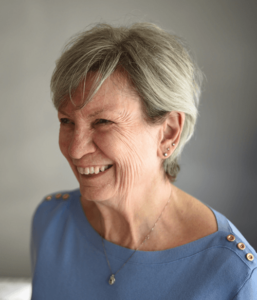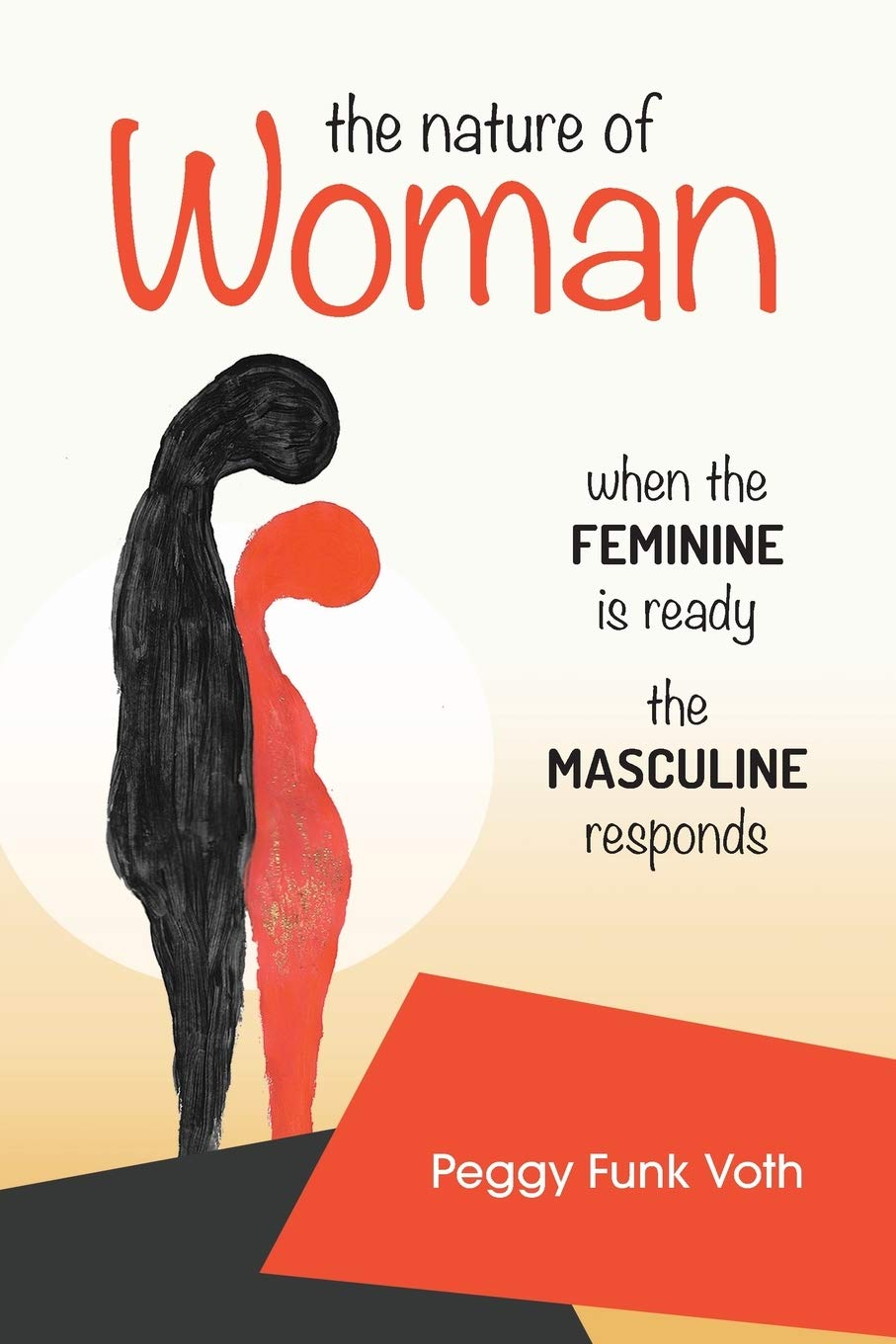The Nature of Woman:
When the Feminine is Ready the Masculine Responds
by Peggy Voth
About the Book
A call to women to accept and live our feminine nature
The essence of the feminine nature is life. Growing from girlhood into womanhood, many of us forget or reject our true femininity. With knowledge and commitment, we can recover the sensitivities and intelligence natural to us as women. When rooted in the wisdom of our personal rhythms and inner knowings, we experience security and a sense of belonging from within. If you desire to Be Woman, the pages of this book invite you in.
”This book is a gift for all women wanting to deepen their experience of the embodied feminine.”
— Anita Johnston PhD, author of Eating in the Light of the Moon
“I spent many years deeply living the question – What is the feminine? Asking inwardly For an answer. Through this period of longing, I was able to call the feminine aspect of myself home. People now ask me for the answer to this question. but I feeI I have only been given a glimpse and no full explanation comes.
It seems though, to truly value the feminine in our culture we need to have an intellectual understanding for it gives us a way to relate to something ineffable or not yet seen. This book The Nature of Woman, can help us, for in it we have been given solid examples and expressions of feminine characteristics and ways in both nature and in behaviour. One woman’s insights, observations and experiences offer us deeper understanding and context for something that is universal and, in a way, invisible. It is no small feat to bring this forth.”
— Megan McFeely, Producer/Director of the film “As She Is”
About the Author
Peggy Funk Voth is a clinical social worker and Jungian analyst in private practice. Her keen interest in the wholesome embodiment and expression of the masculine and feminine principles in everyday life informs her lectures, therapeutic work and gatherings of women.
Peggy underwent thirteen solitudes in accordance with the Seneca Healing Quest that she describes in this book. She grew up on a farm in Texas, married a Canadian, became a mother, a grandmother and a dual citizen, and now lives with her husband in Calgary, Alberta.

Interview with Peggy Voth
Please share a bit about your journey to become a published author?
Writing is the one activity where I lose track of time. It has proven to be my saviour through depressions, the challenges of marriage and parenting, and periods of unknowing and grief.
I dreamed of publishing a book since adolescence. Christmas of 2017, my husband gave me a gift of four days and nights at Banff Centre for the Arts. During that time alone with my laptop, I realized that I needed help clarifying and organizing my book ideas. Shortly thereafter, a friend mentioned Influence Publishing. Looking at their website, Julie Ann’s webinar caught my eye and I enrolled. Six weeks after completing that, I signed a contract with her.
Those of us who attended the webinar continued to meet on our own every month. I benefitted from the mutual sharing of struggles and celebrations with other budding writers. Always patient, astute and optimistic, Julie Ann midwifed my book and I through gestation, labour and delivery.
Show More
How does the writing process work for you? Do you schedule a time every day, work madly when inspiration hits or ?
I write in bits and pieces, both time-wise and word-wise. Often a phrase will come to me just before going to sleep or upon waking. I write it down on a notepad I keep on my headboard. Live music causes ideas and words to flow; I scribble them on the margins of the concert program. In the beginning of a writing project, I write during little breaks in the day – while rice is cooking or the ten minutes before my grandchildren arrive – littering my desk with bits and pieces of paper.
When I begin developing the ideas, it’s usually around 500 words at a time; for that I need an hour or so. The first draft is choppy. More uninterrupted time is required as I move through drafts, fleshing things out, and creating transitions between my 500-word creations. I start ordering in food, abandon my husband, and say “no” to my grandchildren. I go into my writing room and close the door any time I see the possibility of having a chunk of time available. When there is no time for writing, I know that things are percolating inside; an inner composing is going on, and I have learned to trust it.
What did you find most difficult about the writing and publishing process? What was the easiest?
Contrary to the above description of my process, I like structure and order. Therefore, the hardest thing for me about writing is handing myself over to what wants to be expressed and how it wants to be expressed. Sometimes it takes a long time for me to reach a state of allowing what comes forth to determine the shape that my writing takes. Equally difficult is the matter of keeping one foot in my outer life and one foot in the creative life of my inner world so that neither is neglected. It’s a constant juggling act.
The easiest part of writing this book has been working with the feedback of others: Julie Ann, my structural editor; Danielle Anderson, my content editor; and my readers. Their eyes saw what I could not see, expanding or tightening my focus and style. Regarding the publishing process, once my manuscript was ready, it was like little Influence elves came out of the woodwork, guiding and coaching me. Marketing is the hardest for me as I’m not very familiar with social media nor does it fit my personality.
What title have you released? Can you share a bit of what it is about?
The Nature of Woman: When the Feminine Is Ready, the Masculine Responds is my first book. In it I write about the “natural” feminine, which is the essence that resides deep within us as girls and women. Many of us have been socialized into a false femininity robbing us of the inner security that comes with being rooted in our feminine nature.
What does it mean to be genuinely feminine? What does that look like? Underneath our compliant or rebellious selves, who are we as women? What makes us tick?
My book explores basic features of the natural feminine like inner timing, instinct, and body-knowing. In the process of growing up and entering the public world, these traits may become forgotten or rejected. With knowledge and effort, they can be reclaimed. As we women learn to value the feminine capacities within ourselves, I believe a healthy masculine response will be called forth in the patriarchy and in our men.
Do you have any new books in the planning or writing stage?
I am considering the possibility of publishing a manuscript already written called “13 Solitudes: An Initiation into the Feminine.” First, though, I want to see how my current book is received.
What would you like readers to know about you?
Trained as a clinical social worker and a Jungian analyst, I have a private practice as a depth psychotherapist. I’ve co-partnered a counselling business, run many workshops for women and presented at events in Canada and the U.S. My abiding interest, in work and in life, is understanding the deep workings of the archetypal feminine, particularly in women.
Anything else you’d like to share?
The female body houses the natural feminine. When a woman accepts this reality, welcomes it and lives it, she comes home to herself. The consciously embodied feminine makes a woman voluptuous, filling out her personality, plumping her sense of self, bringing curvatures to her presence. She becomes sensual through and through, from her laugh to her ideas, from her touch to her deeds. A magnetism unique to the feminine character flows through the woman, perfumes the atmosphere, draws forth the magic of the moment. The inner feminine enlivens the woman who embraces her and, through that woman, brings the world around her to life.
